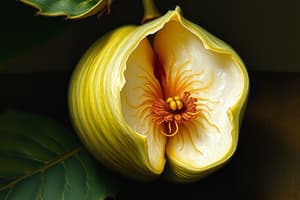Podcast
Questions and Answers
What is the primary outcome of the first sperm cell in double fertilisation?
What is the primary outcome of the first sperm cell in double fertilisation?
- Formation of triploid endosperm
- Development of the ovule
- Fertilization of polar nuclei
- Creation of a diploid zygote (correct)
What role does the triploid endosperm play in angiosperm reproduction?
What role does the triploid endosperm play in angiosperm reproduction?
- It enhances genetic diversity
- It regulates pollen tube growth
- It protects the zygote during early development
- It provides nutrition for the developing embryo (correct)
Why is double fertilisation considered advantageous for seed viability in angiosperms?
Why is double fertilisation considered advantageous for seed viability in angiosperms?
- It produces seeds with higher genetic diversity
- It leads to the formation of multiple zygotes
- It creates a triploid endosperm that nourishes the embryo (correct)
- It results in larger pollen grains
Which type of fertilisation is unique to angiosperms?
Which type of fertilisation is unique to angiosperms?
How does the endosperm influence seed germination?
How does the endosperm influence seed germination?
What potential benefit does understanding double fertilisation have for agriculture?
What potential benefit does understanding double fertilisation have for agriculture?
Which statement accurately describes multiple fertilisation?
Which statement accurately describes multiple fertilisation?
What is a key outcome of manipulating fertilisation processes in plants?
What is a key outcome of manipulating fertilisation processes in plants?
Study Notes
Mechanism of Double Fertilisation
- In angiosperms, double fertilisation involves two sperm cells from a pollen grain.
- One sperm fertilizes the egg cell, forming a diploid zygote.
- The second sperm fuses with two polar nuclei in the central cell, creating a triploid cell that develops into endosperm.
- This process occurs within the ovule of the flower after pollen tube growth.
Role in Angiosperm Reproduction
- Double fertilisation ensures efficient seed development by providing nutrition (endosperm) for the developing embryo.
- It allows for the formation of seeds that are more viable due to the triploid endosperm.
- Enhances genetic diversity through sexual reproduction.
Importance in Plant Development
- The endosperm nourishes the embryo during seed development.
- It plays a role in seed germination, providing essential nutrients for initial growth.
- Facilitates the evolution of larger seeds with better survival rates due to stored food.
Comparative Fertilisation Methods
- Single Fertilisation: Occurs in some gymnosperms where only one sperm fertilizes the egg.
- Multiple Fertilisation: Found in certain species, where more than two sperm cells participate in fertilization.
- Double fertilisation is unique to angiosperms, setting them apart from other plant groups.
Implications for Agriculture
- Understanding double fertilisation can enhance crop breeding techniques by improving seed and fruit quality.
- Manipulating fertilisation processes may lead to better yields and more resilient plant varieties.
- Research on double fertilisation can aid in developing hybrid plants with superior traits.
Mechanism of Double Fertilisation
- Double fertilisation in angiosperms involves two sperm cells from a single pollen grain.
- One sperm cell fertilizes the egg cell to form a diploid zygote.
- The second sperm cell merges with two polar nuclei in the central cell, resulting in a triploid cell that becomes the endosperm.
- This process takes place within the ovule following the growth of the pollen tube.
Role in Angiosperm Reproduction
- Double fertilisation guarantees effective seed development by supplying essential nutrients through the endosperm for the embryo’s growth.
- The presence of triploid endosperm increases seed viability.
- This mechanism contributes to genetic diversity, promoting variation through sexual reproduction.
Importance in Plant Development
- The endosperm provides nourishment to the embryo during seed development.
- It is crucial for seed germination, offering necessary nutrients for the initial growth phase.
- The process has led to the evolution of larger seeds, enhancing survival rates due to additional food storage.
Comparative Fertilisation Methods
- Single Fertilisation: Found in some gymnosperms where one sperm fertilizes the egg.
- Multiple Fertilisation: Observed in specific species, involving more than two sperm cells during fertilization.
- Double fertilisation is distinct to angiosperms, differentiating them from other plant groups.
Implications for Agriculture
- Insights into double fertilisation can improve crop breeding techniques, leading to enhanced seed and fruit quality.
- By manipulating fertilisation processes, agricultural practices may achieve better yields and develop more resilient plant varieties.
- Research on double fertilisation holds potential for creating hybrid plants exhibiting superior agricultural traits.
Studying That Suits You
Use AI to generate personalized quizzes and flashcards to suit your learning preferences.
Description
This quiz explores the mechanism of double fertilisation in angiosperms, detailing the roles of sperm cells, zygote formation, and the significance of endosperm. Understand how this process contributes to seed development and enhances plant reproduction. Test your knowledge on the intricate processes that promote genetic diversity and support embryo nourishment.




